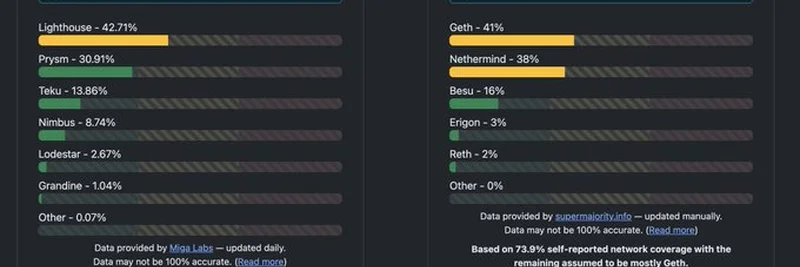Hey there, crypto enthusiasts! If you’ve been following the latest buzz on X, you might have stumbled across an intriguing thread by sassal.eth/acc. This post dives deep into why Ethereum stands out as a rock-solid blockchain, thanks to its clever design featuring multiple clients. Let’s break it down and see what makes this network so resilient!
What’s All the Fuss About Client Diversity?
Imagine if a single software glitch could bring down an entire network—yikes! That’s a risk many centralized systems face. Ethereum, however, has a brilliant solution: client diversity. This means the network runs on several different software clients for both its consensus layer (which agrees on the state of the blockchain) and execution layer (which processes transactions). The idea? If one client hits a snag, the others keep the show running.
In the shared images, you can see the latest stats:
- Consensus Clients: Lighthouse leads at 42.71%, followed by Prysm (30.91%), Teku (13.86%), Nimbus (8.74%), Lodestar (2.67%), Grandine (1.04%), and others (0.07%).
- Execution Clients: Geth dominates with 41%, Nethermind at 38%, Besu at 16%, Erigon at 3%, Reth at 2%, and others at 0%.
These numbers, sourced from Miga Labs and Supermajority.info, show a healthy spread. The thread highlights that this diversity has improved over time, reducing the risk of a single point of failure.
Why Does This Matter?
Ethereum’s creators made a smart move early on by prioritizing multiple clients. Think of it like having multiple backup generators—if one fails, the lights stay on. This anti-fragile design (a term sassal.eth loves!) means the network can handle bugs or attacks without collapsing. Other blockchains? They often rely on just one or two clients, making them more vulnerable.
Plus, Ethereum doesn’t stop at client diversity. It also:
- Avoids overloading the main layer (Layer 1) with too much traffic.
- Encourages solo stakers to keep the network decentralized.
- Penalizes offline validators with inactivity leaks.
- Tests upgrades thoroughly before rolling them out.
No wonder sassal.eth calls Ethereum the “no second best anti-fragile network”!
A Peek at the Bigger Picture
This focus on resilience ties into Ethereum’s broader mission. By spreading the load across clients like Lighthouse, Prysm, and Geth, the network stays robust even as it scales. For meme token fans and blockchain practitioners, this is a goldmine of insight. A stable base like Ethereum can support innovative projects, including those wild meme coins you love on meme-insider.com.
So, next time someone doubts Ethereum’s uptime, point them to this client diversity magic. It’s not just tech—it’s a safeguard for the future of decentralized finance and beyond!
What do you think about Ethereum’s approach? Drop your thoughts in the comments, and stay tuned for more blockchain deep dives here at Meme Insider!


